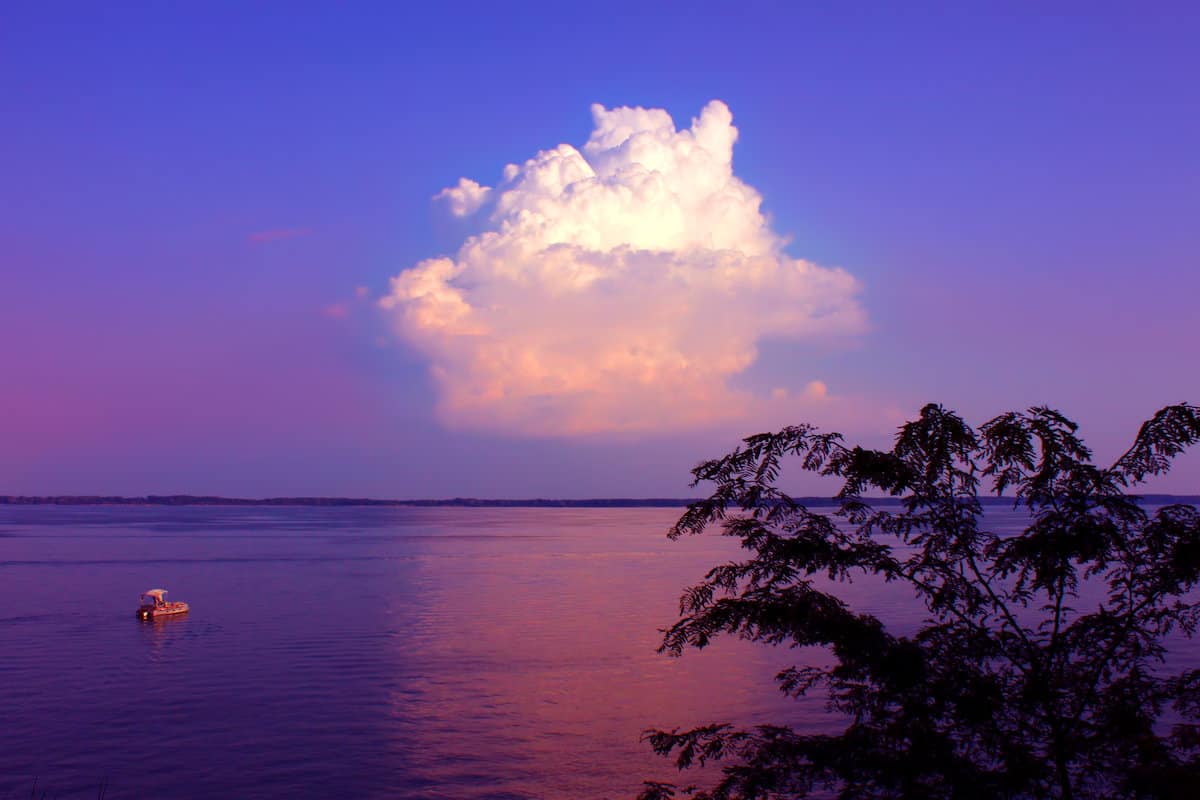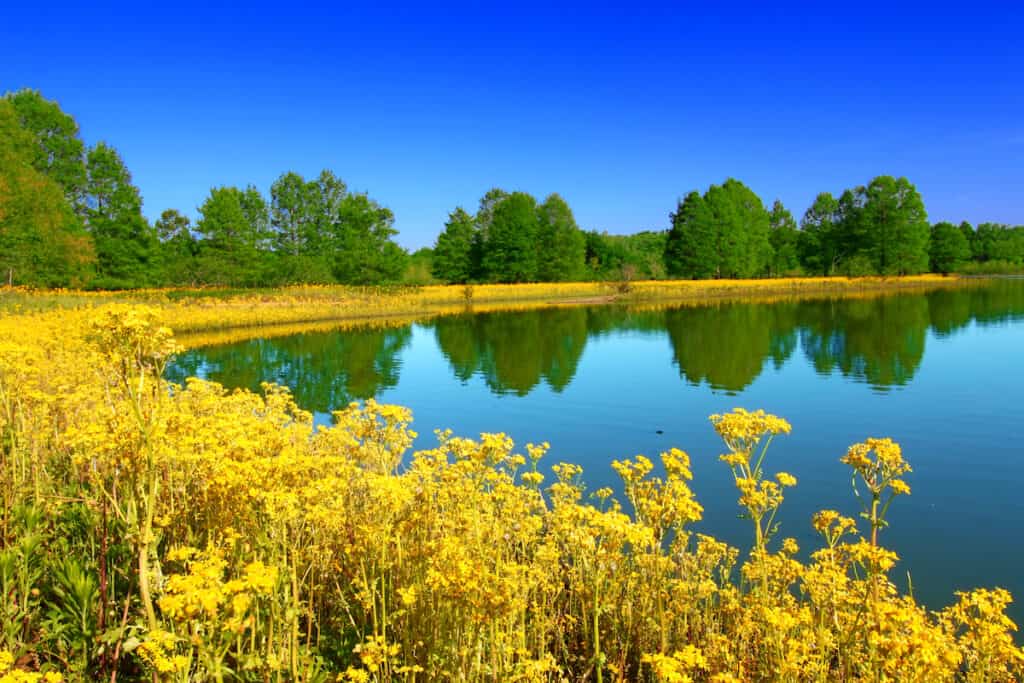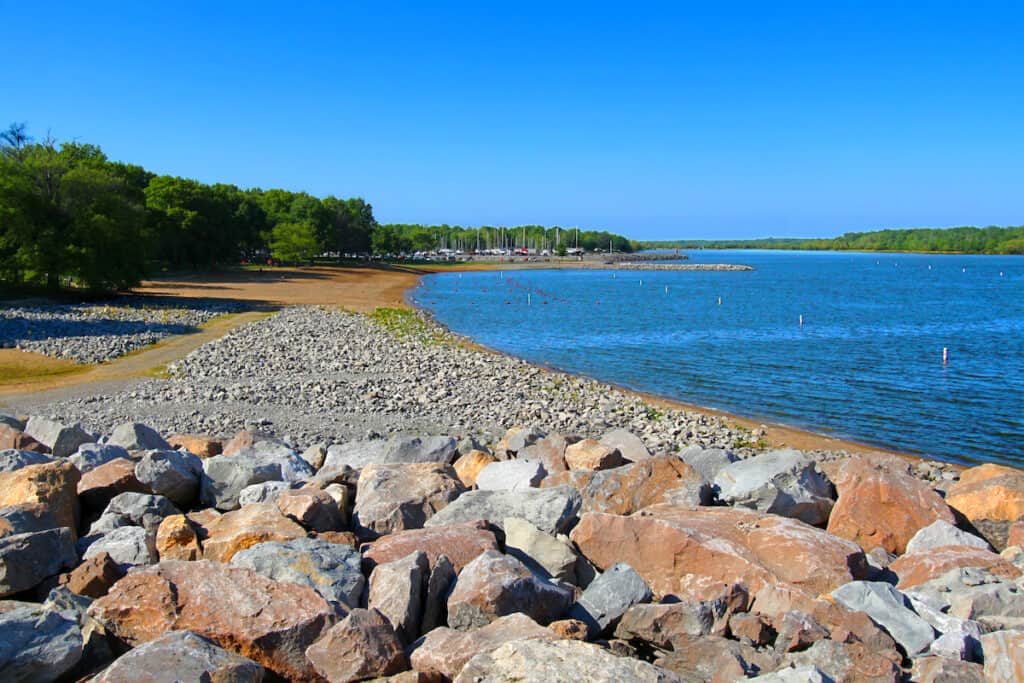Though it’s the largest inland reservoir in Illinois, Carlyle Lake hasn’t always enjoyed a reputation for great fishing. Not that long ago, it was thought of as a big lake with few fish, and it wasn’t uncommon to hear it referred to as the dead sea.
But that reputation has changed, thanks in large part to the Illinois Department of Natural Resources’ efforts, which include an ongoing stocking program and the placing of artificial fish habitat structures throughout the reservoir.
These days, Carlyle Lake is unquestionably one of the best catfish lakes in Illinois and a very respectable panfish lake. Bass fishing has improved, too, though it may be a while before Carlyle develops a trophy bass fishery.
The creation of Carlyle Lake took place from 1958 to 1967 with the construction of the Carlyle Lake Dam on the Kaskaskia River. The 26,000-acre reservoir (sometimes known as Carlyle Reservoir) spans portions of Clinton, Fayette and Bond counties in South-Central Illinois.
For fishing purposes, it’s often helpful to break Carlyle Lake down into two sections:
The upper third of Carlyle Lake, above the Burlington Northern railroad tracks that span the reservoir from Boulder to Keyesport, is shallow (about 8 feet max) and loaded with stumps and timber.
The lower two-thirds are broad and open, with depths up to 35 feet and little natural cover outside of the bays and coves, which have some good swaths of standing timber.
Both areas provide quality fishing opportunities, and the best places to target depend on the season. And it would be wise to remember the spillway below the dam, which offers fishing that sometimes outshines the main lake.
Catfish Fishing
Carlyle Lake offers a truly exceptional catfish fishery and is generally considered one of Illinois’ “Big Three” catfish lakes, along with Rend Lake and Lake Shelbyville. Channel catfish, in particular, are abundant and widespread throughout the reservoir.
Catfish surveys by the Illinois DNR tend to be fairly consistent, turning up good numbers of channel cats measuring 18 to 31 inches and weighing 3 to 9 pounds. Bigger fish are also available, but most tend to be in this range.
Flathead catfish are also available, though they are less common than channels. Carlyle Lake has produced former state record flatheads over 70 pounds, and fish in the 20- to 30-pound range are frequently caught.
The DNR also started stocking blue catfish in Carlyle Lake in 2020. At present, this fishery is still developing, but as blue cats grow, there’s a lot of potential for this to develop into a trophy blue catfish lake.
Anglers can take advantage of great catfish action here from spring through fall. The upper portion of the lake above the railroad tracks is especially good, with its abundance of woody cover in 3 to 8 feet of water.
But areas all over the lake can be productive, especially for channel cats, which anglers catch from shore at Carlyle Lake’s numerous public access sites.
Chicken livers, dough baits, blood baits, live nightcrawlers, and cut shad are all excellent bait options.
One of the best times to target catfish is in June and July, when channel cats spawn. They’re attracted to rocky crevices this time of year, and the riprap that lines the railroad crossing and the shorelines around many of the lake’s boat launch sites is reliably productive.
In summer, drifting baits in open water is often a great way to find some of the biggest catfish in the reservoir. Carlyle Lake has an easily identifiable creek channel. Bends in the channel are great places to start.
When a thermocline develops in summer, active catfish usually feed right above the thermocline at around 12 feet, making that the best depth range to fish. The best bite is often at night, especially for flatheads.
Crappie Fishing
Illinois has a lot of really excellent crappie lakes, and Carlyle Lake is one of the best in the central part of the state.
Spring is prime time for crappies, and shallow areas all over the lake offer great potential.
Both black and white crappies are available in Carlyle Lake, with the latter being the dominant species. Both populations can be cyclical, but recent years have seen anglers catching lots of healthy keepers measuring 10 to 14 inches.
April and May are the best times to catch your limit, which is 15 fish per day on Carlyle Lake. Practically any shallow cover can attract crappies this time of year, though brush and other woody cover tends to be best.
There’s often great spring crappie fishing among the shallow trees and stumps at the upper end of Carlyle Lake. The railroad bridge is also an excellent area to fish, especially around the short bridges that span the gaps in the earthen rail causeway.
But the best spots are usually in the shallow coves off the main lake. Allen Branch on the southwest side is outstanding, with broad areas of stumps and thousands of Christmas trees that have been placed on the bottom by the DNR.
Coles Creek and the Peppenhorst Branch, also in the reservoir’s lower part, are great spring crappie spots. And anglers often do well from the bank at the Dam West Access and the Boulder Access.
Crappies tend to scatter in deeper water in summertime and can be difficult to find. Schools of them often show up in timber-filled areas and around marina docks at dusk, and lighted areas are often excellent after dark on summer nights.
Small gizzard shad are the top crappie forage in Carlyle Lake, and jigs that mimic shad tend to be the best baits. Try a Bobby Garland Baby Shad or a Bass Assassin Tiny Shad on a 1/16-ounce jig head.
Live minnows are also impossible to beat, especially when the bite is a little tougher, or crappies head deep into snaggy cover. Suspending a minnow beneath a float or “dipping” one into brush with a long rod can get bites when nothing else will.
Bass Fishing
In general, many anglers consider Carlyle Lake a good-not-great bass lake. The largemouth bass population has had some ups and downs, including some banner years. But most years, you’ll find better bass action at Rend Lake or Lake Shelbyville.
Still, Carlyle Lake isn’t a total bummer where bass are concerned. The lake supports a healthy largemouth population, and anglers catch respectable numbers of largemouths in the 12- to 16-inch range. Occasional giants top 6 pounds, but such fish are rare.
The DNR has been stocking advanced fingerling largemouth bass in recent years to help bolster the population. And the bass caught here tend to be fat and healthy thanks to abundant gizzard shad.
Spring is the best time to catch bigger bass when chunky pre-spawn females head toward Carlyle Lake’s coves. The area above the railroad tracks is a good bet in early spring and can be productive through June if water levels allow.
Down on the main lake, bass spawn in late May in the backs of coves like Peppenhorst and Allen Creek, both of which are on the west side of the reservoir. Both also offer an abundance of flooded timber.
In spring, rains can muddy the water quickly, so it’s always a good idea to have something flashy handy, like a spinnerbait. Shad imitations like Zoom Flukes and Rapala Shad Raps are also great choices.
Largemouths commonly relate to riprap in Carlyle Lake, and there’s a lot of it at various boat launch sites. The shoreline between the Peppenhorst and Allen Creek branches is almost entirely lined with riprap.
Try running a shallow crankbait parallel to riprap banks.
Wacky worms and Carolina-rigged soft plastics also excel as the water warms up in summer and bass transition a little deeper toward the creek channel.
Other Fish Species
Carlyle Lake is home to many types of fish other than those listed above. Some, like bullhead, freshwater drum and common carp, are abundant though seldom targeted by anglers. But others are just as prized as the game fish listed above.
White Bass
Carlyle Lake supports a prolific white bass population. DNR surveys of this species consistently result in high catch rates and good size structure, with lots of fish measuring 12-plus inches and weighing a pound or more.
The month of April finds white bass heading toward the upper end of Carlyle Lake and into the backs of its many coves to spawn. Lots of these fish are caught on shad-imitating jigs, spinners and crankbaits this month, with silver and white being top colors.
In summer, white bass roam the open lake in vast schools that anglers can often spot on electronics. They can also be identified by the splashes and circling gulls that indicate white bass feeding on shad at the surface.
As good as the white bass fishing can be on the main lake, it’s often even better below the spillway. White bass stack up in the tailwater section of the Kaskaskia River in late summer, and the bite is often non-stop right around dusk.
Catch More White Bass
A white bass angler’s favorite fishing techniques and tips
Sauger
Sauger are native to the Kaskaskia River, and this waterway continues to be one of the top sauger fisheries in the state. The Carlyle Lake tailwater is consistently one of the top sauger spots on the river.
Spring and fall are peak seasons for sauger, a close relative of walleye that gravitate to current breaks below the spillway. Try a jig/minnow combo early in the morning or late in the evening.
The main lake also offers some major sauger opportunities. The DNR has been stocking these fish in Carlyle Lake for many years. Although they are neither as abundant nor as easy to catch in the main lake as they are in the river, they’re often bigger.
Prime areas are drop-offs to the old creek channel, submerged islands and humps. Drifting or trolling a jig and minnow along the creek channel is the most consistently effective tactic, though some nice sauger are also caught along riprap shores in early spring.
Bluegill & Sunfish
An abundant bluegill population in Carlyle Lake provides great panfish angling throughout the warmer months. Ice fishing for bluegill can also be good in the lake’s coves during winter, though the ice fishing season here is typically brief.
Bluegill size isn’t especially impressive—lots of fish measure 6 inches, but few exceed 7—but these panfish readily bite small jigs and live worms around docks, weed beds, brush piles and timber.
The DNR has also begun a redear sunfish stocking program, which should add an additional option for panfish anglers in the future.
Redear sunfish grow larger than bluegill, and are more bottom-oriented, dining primarily on snails and mollusks.
Catch More Bluegill and Sunfish
Check out our simple guide to bluegill and sunfish fishing, including top bait and tackle.
Planning Your Trip
Carlyle Lake is a popular recreation lake, so expect a fair amount of boat traffic on the lower two-thirds of the reservoir. That being said, the area above the railroad tracks is essentially visited only by anglers and paddlers.
The small city of Carlyle is the only major population center on Carlyle Lake, offering a variety of options for shopping, dining and lodging at the reservoir’s southern end near the dam.
You’ll also find a few shops and restaurants in the small village of Keyesport, toward the upper end of the lake.
Getting to Carlyle Lake
Carlyle Lake is about 90 minutes south of Springfield via I-55 and IL-127. It’s also less than an hour east of St. Louis, MO, via I-64 and US-50.
Bank & Boat Access
Access is abundant on Carlyle Lake, with numerous shore fishing sites and about a dozen boat launches maintained by both the Illinois DNR and the U.S. Army Corps of Engineers. Some of the best places to get on the water (clockwise, starting at the dam) include:
- Dam West Access: A fishing pier, four-lane boat ramp ($5 fee), swimming beach and campground are all available at this access area, which is just west of the dam and spillway. The West Access Marina is also located here and offers boat rentals.
- Eldon Hazlet State Recreation Area: One of the largest and most popular spots on Carlyle Lake, Eldon Hazlet State Recreation Area offers fishing access, campsites, and cabins on the west side of the lake. The park has two boat launch sites, one on Casey Dempsey Cove and one on the Allen Branch.
- Keyesport: The Corps of Engineers manages a public boat launch with courtesy docks and a fish cleaning station in Keyesport, adjacent to the Keyesport public beach. The fee to launch is $5.
- Horseshoe Island Access: Located immediately above the Burlington Northern railroad tracks on the west side of Carlyle Lake, the Horseshoe Island Access offers free public boat ramps and bank fishing, making this a popular spot on the upper end of the lake.
- Tamalco Boat Ramp: The Tamalco launch site is another free public launch on the upper portion of the lake, located at the end of Tamalco Avenue. Bank fishing access is available.
- Patoka Access: On the east side of Carlyle Lake’s shallow upper section, the Patoka Access is almost directly across from the Tamalco site and offers similar amenities.
- Boulder Recreation Area: Under the management of the U.S. Army Corps of Engineers, the Boulder Creek Recreation Area is just south of the rail crossing on the east side of the lake. This area includes a two-lane ramp ($5 fee), bank fishing, a campground, and the Boulder Marina.
- Coles Creek Recreation Area: A four-lane ramp ($5 fee), fishing pier, and campground are available at the Corps of Engineers-operated Coles Creek Recreation Area, located just north of its namesake creek arm on the east side of the lake.
- Dam East Recreation Area: The Dam East Recreation Area (formerly South Shore State Park) is one of the largest Corps of Engineers sites on the lake, offering a four-lane boat ramp ($5 fee), fishing pier, swimming beach and campground, along with ample bank fishing access.
- Spillway Recreation Area: Access to the tailwater section of the Kaskaskia River below Carlyle Lake is available through the Corps-operated Spillway Recreation Area.
Know Before You Go
Boating on the upper third of Carlyle Lake requires caution, as there are many areas where standing timber tops out just inches below the surface. Low water makes this area especially hazardous in summer.
Rough water can also prove challenging on the main lake, which is popular among sailboaters and known as the windiest of Illinois’ reservoirs. Sheltered coves on the west side of the lake are the safest bets on breezy days.



